This is a fortnightly newsletter about the New Zealand Net. If you would like to be notified by email when a new edition is published, please contact ZL1NZ.
Browse our newsletter Archive and List of Net Tips.
Featured key
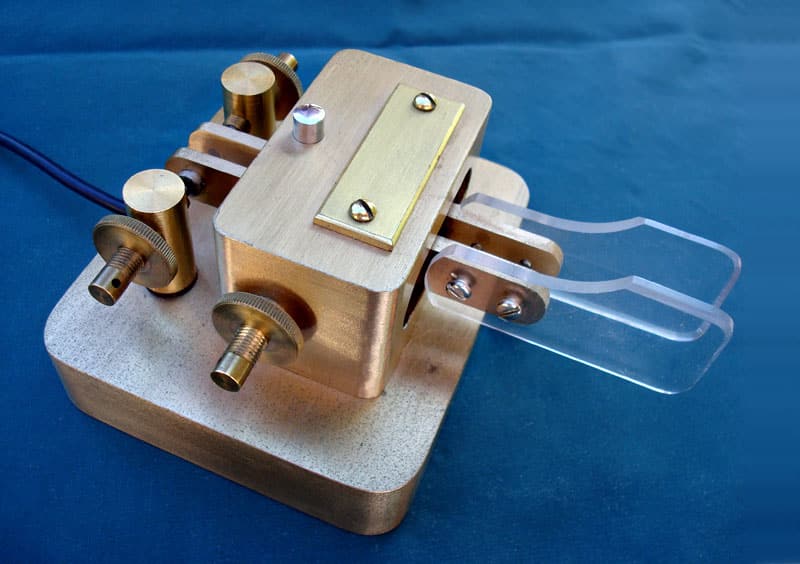
Zedder paddles. Photo: ZL2WT
By David ZL2WT
After reading Barry Kirkwood’s 1996 review of the Zedder paddles in Morsum Magnificat (see below), I made contact with Peter Byam ZL2JJ, designer and builder of the Zedder – one of the world’s rarest and most exquisite Morse keys.
I got to spend time with Peter when I called on the Waitotora freezing works to attend to their IT network, but little did I know that a conspiracy was underway…
My XYL, Raeanne, was secretly arranging for Peter to make me a set of his custom-built paddles, and she presented them to me for my 50th birthday. Regrettably, it was 20 years before I started to master the use of the key (serial number 20), and still I’m not using it in iambic mode!
I believe that Peter had once been a US Navy pilot, delivering planes to Hawaii. He was also an ocean yachtsman. He partnered with R Tucker Thompson to import pineapple drying machines from Hawaii for use in the NZ grain drying industry. (Thompson went on to commence building the famous schooner that bears his name.)
Peter ran a grain-drying business and later went farming in Taranaki. Next to his modern house was his old farm house, most of which was dedicated to radio and engineering. It included model steam engines, all perfectly crafted by Peter.
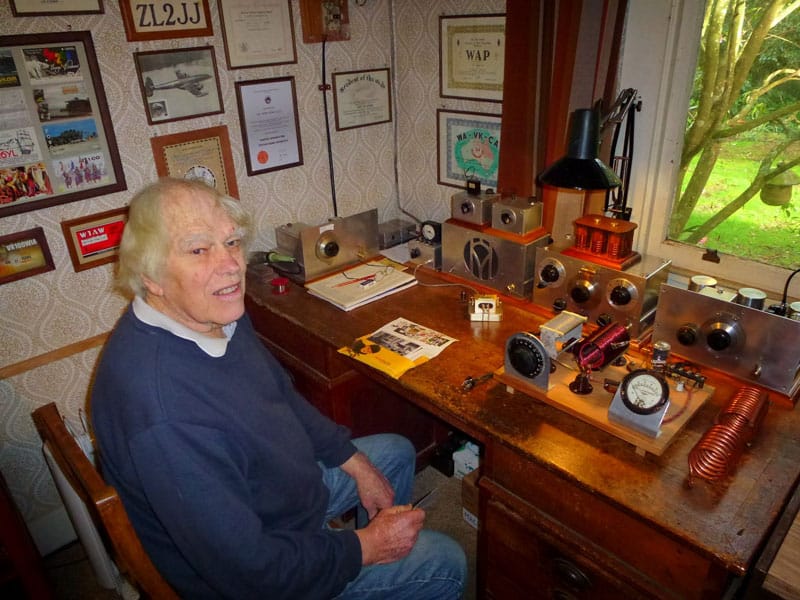
Peter Byam ZL2JJ with his Zedder key and homebrew 1930s-style ham equipment. Photo: Barry Kirkwood
Peter did not fuss about antennas. He used a single length of wire which went from the window to a nearby tree. Into the desk was built a send/receive switch – no QSK for him. The switch can be seen at the left rear corner of the Zedder key in the photo above.
The TRF receiver just to the right of the Zedder key in the photo above was his pride and joy – the ultimate version of what he had been aiming at. I think he wrote an article on it that was published in a magazine.
One afternoon, I visited Peter and he could pick up a QSO to Europe on 20m at the drop of a hat. But, that was a time when the solar flux was being friendly!
In an adjacent room was a tall rack of brown boxes. These boxes, a bit smaller than a wine-box, were obtained from a dairy laboratory, where they had previously been used for butter or cheese samples (I can’t remember which). There was a huge number of these boxes, and each contained one of Peter’s creations. There were all beautifully engineered, always valve technology and I bet every one of them worked perfectly.
Peter died on 5 January 2016, aged 83. I do hope someone is taking care of his creations.
Comment:
Chris ZL2LO in Wanganui has most of Peter’s gear. Chris did a show of them at Br20 a year or so ago including his “Vintage tx” which I believe was on the front page of a Break-In magazine.
– Peter ZL2AUB
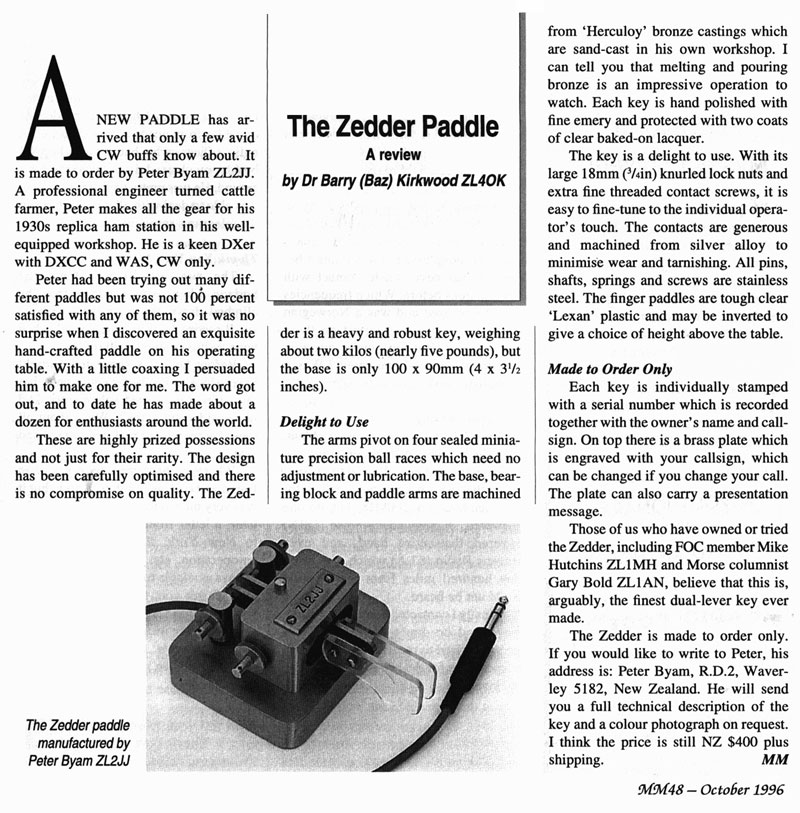
* If you have an interesting key for this feature, please send me a nice clear photo and a few words describing it.
Quick notes
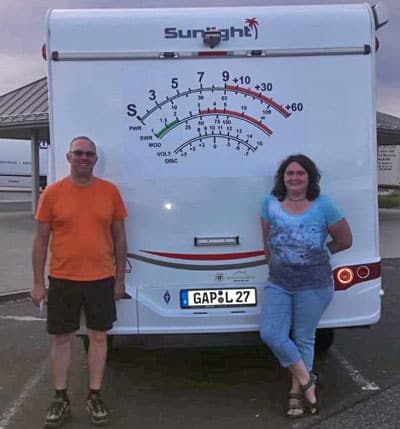
NZ Net’s web address is now nzcw.net. The Net’s web pages have not moved (although perhaps they will one day) but we now have an address that’s easier to send in radiograms, or to give to people who might be interested in learning about what we do. Simpler than zl1.nz/nznet, although that will continue to work too.
NZ Net fliers have been updated with the new web address. You are welcome to download and print these fliers for your radio club meetings, hamfests, etc.
Dave ZL4LDY is still grappling with IT problems that are preventing him from getting on the air via the remote station in Blenheim.
Photo: DK8PL and DO9JBL with their distinctive campervan
Photo flashback
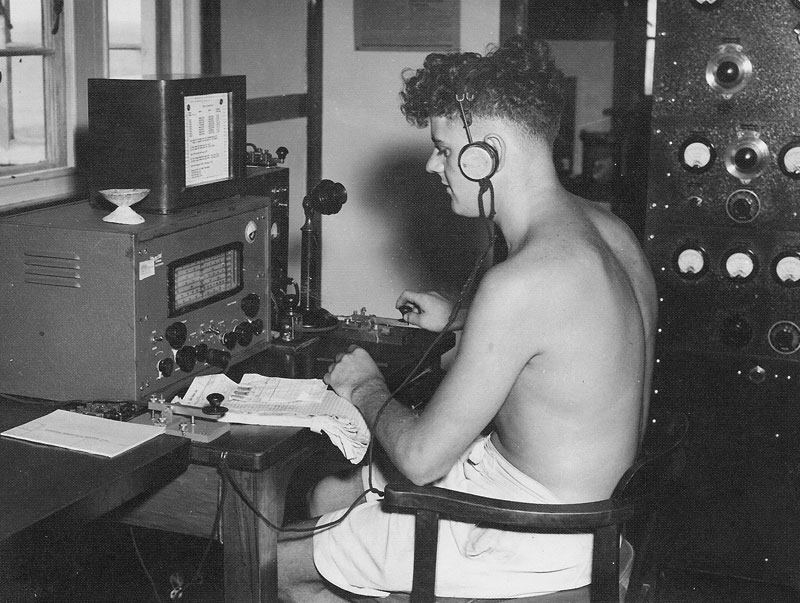
Lloyd (Cookie) Douglas at Raoul Island Radio ZME in late November 1949. Photo: Clyde Williams
The Kermadec Islands were in the news a couple of weeks ago, after two large earthquakes occurred in the area, raising tsunami warnings in the South Pacific. You can read about Raoul Island Radio ZME in this first-hand account by radio operator Clyde Williams.
Morse musing: learning the code
Our series continues, this time with Steve ZL4KL recalling how he learned the Code. If you haven’t sent me your story yet, please do!

Steve, looking bleary-eyed after a stormy night aboard QE2
I was brought up in Liverpool with “the wireless” and I often used to marvel when darkness fell and distant stations would roll in, with exotic names like Hilversum.
I heard hissing sounds in the background and my seagoing grandfather explained that it was Morse code. I was hooked, and turned to scanning the airwaves for this strange sound.
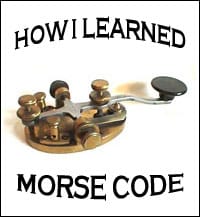 My grandfather always used to tell me the Radio Officer’s job was the best one on the ship – he must have known as he served on some of the biggest and most famous Cunard liners going!
My grandfather always used to tell me the Radio Officer’s job was the best one on the ship – he must have known as he served on some of the biggest and most famous Cunard liners going!
Many years later, after leaving school and trying to decide what to do with my life, I was introduced to the world of ham radio. I jumped in to the study and was mentored on Morse by Tony G4SYW, a local ham. By this stage I had a Realistic DX-302 receiver, enabling me to listen to the ham bands. I sat the ham exam, quickly followed by the Morse test a few weeks later.
A friend suggested I attend the marine radio college in Liverpool and, after looking at the prospectus, I took the plunge. As I could already send and receive Morse, courtesy of my ham background, the course was eventually a lot easier for me than the other students.
Three years later I passed the exams, but was destined for jobs away from the marine environment, much to my disappointment, as at the time the merchant marine was in declined. Then one day I got a call asking if I was interested in a job on Queen Elizabeth 2. What a silly question!
I attended an interview at the famous Cunard Building at Pier Head in Liverpool, in the boardroom overlooking the River Mersey where the very ship I was being interviewed for was dreamed up and designed.
I was successful and had the essential medical, etc. The rest, as they say, is history. I still use my ITT Marine key for Straight Key Night, one that was given to me by the Chief R/O of QE2.
After a far-too-short time on QE2 (which is a story in itself) I ended up working on Royal Fleet Auxiliary ships, supporting the Royal Navy around the world.
And the saddest part is, the only time I got to use “real Morse” was as we were outbound from Rosyth bound for Portsmouth after refit, sailing under the famous Forth Bridge. But for me, it is still the best mode, bar none.

QE2 in Liverpool, 2004. Photo: Eric the Fish
How did you learn CW? Drop me a line and I’ll post the replies in future newsletters.
Sideswiping
The featured key in our previous newsletter was the Bunnell Double-Speed, a sideswiper. If you’d like to know more about sidesipers, I recommend visiting the QRZ.com page of K5MP. Mike has built several of these keys and has lots of info on the very many ways they can be used.
Audio challenge: HLG traffic list
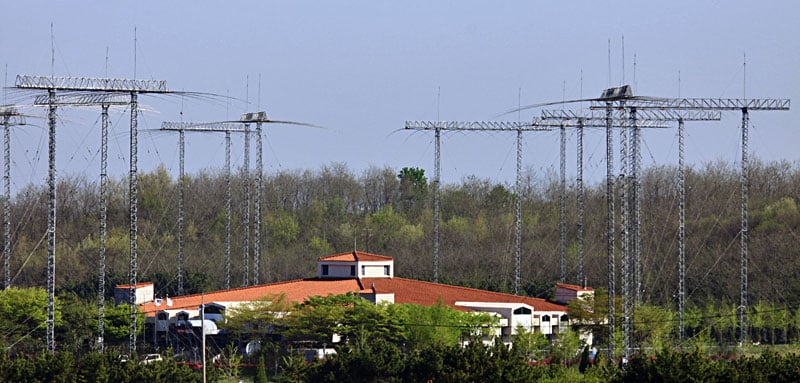
HLG transmitter site in Seoul
I was tuning past 8484kHz around 1000Z a couple of weeks ago, when I heard South Korean coast station HLG announcing they had a traffic list coming up, so I started the recorder.
Now, here is a wee challenge for you. Listen to the HLG traffic list and copy the callsigns of the stations for which they are holding traffic. The callsigns are quite readable, as each of them is sent twice.
Then, send me your list of callsigns (preferably as text in a radiogram on the Net but, if you cannot get on the Net, then an email will do). Correct answers will be in the next newsletter. Good luck!
How to communicate with a fone operator
On rare occasions I venture into the fone bands, where I’ve learned that it’s important to make sure the other operator understands what I’m saying, since spoken letters can sound similar.
To achieve clear communication, I rely on the following Fonetic Alphabet for CW Operators (or Fone-E Alphabet, for short). Try it, and I’m sure you’ll be amazed by the difference it makes.
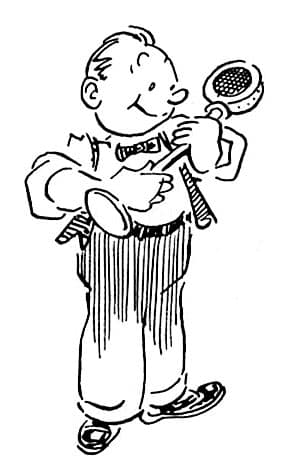
It’s also important to hold the talk thing properly.
Cartoon: Gildersleeve
Are
Begali
Cue
Double-U
Eye
Fore
Gnat
Heir
Iambic
Jalapeño
Know
Llewellyn
Mnemonic
Nyctanthous
One
Pterodactyl
Q-Signal
Radiotelegraphy
Sea
Tsunami
Undulator
Vibroplex
Why
Xylophone
You
ZC1*
* Overseas readers may not be aware that the ZC1 was a New Zealand-designed and built CW/AM transceiver used during World War 2, and then widely adopted by NZ hams following the War.
Net tip: QNK
If you list traffic when you check into NZ Net, Net Control Station will inform you when it’s time to send your traffic.
Overseas nets typically send stations off frequency to handle traffic, but because we handle relatively little traffic on NZ Net, it is normally passed on the Net frequency just before the Net closes.
Net Control Station will use the signal QNK, meaning “Transmit message for _____ to _____ ” as in this example:
ZL1ANY QNK ZL2GD ZL2KE
which means “ZL1ANY please send your traffic for ZL2GD to ZL2KE”.
Since very few messages on NZ Net are passed via a third station, we’re more likely to hear:
ZL1ANY QNK ZL2GD
which means “ZL1ANY please send your traffic to ZL2GD”.
The signal QNK is only to be used by the Net Control Station.
See the full List of NZ Net Tips.
Advertising archive

Suggestions?
If you have suggestions on how to make the NZ Net better, or things you’d like to see covered in these updates, please contact ZL1NZ. You might even like to write something for the newsletter.
Thanks for reading, and I hope to see you soon on the NZ Net!
—
Neil Sanderson ZL1NZ, Net Manager
New Zealand Net (NZ NET)
3535.0 kHz at 9pm NZT Mon-Fri

%20Dark%20Logo%20BIG%20TM.png)
